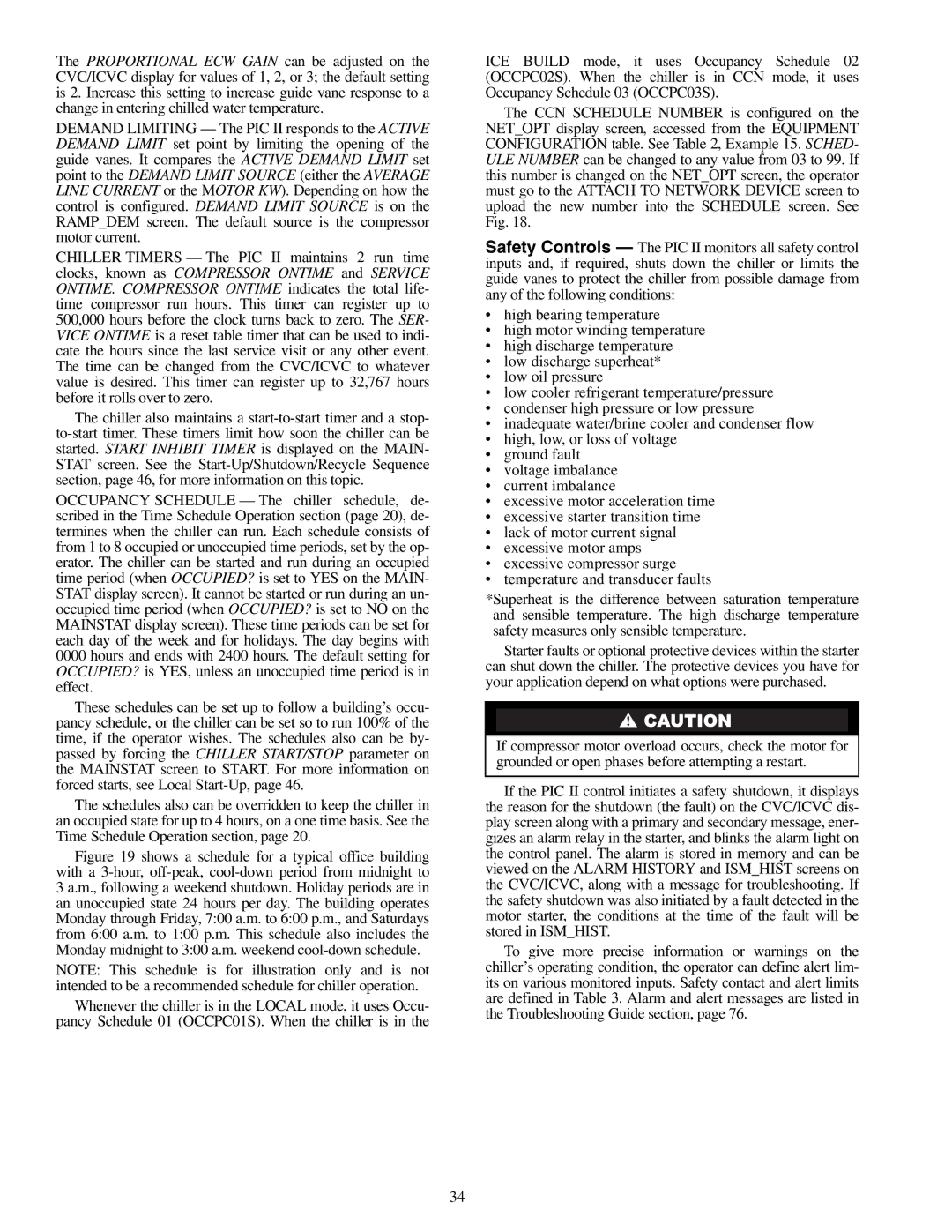The PROPORTIONAL ECW GAIN can be adjusted on the CVC/ICVC display for values of 1, 2, or 3; the default setting is 2. Increase this setting to increase guide vane response to a change in entering chilled water temperature.
DEMAND LIMITING — The PIC II responds to the ACTIVE DEMAND LIMIT set point by limiting the opening of the guide vanes. It compares the ACTIVE DEMAND LIMIT set point to the DEMAND LIMIT SOURCE (either the AVERAGE LINE CURRENT or the MOTOR KW). Depending on how the control is configured. DEMAND LIMIT SOURCE is on the RAMP_DEM screen. The default source is the compressor motor current.
CHILLER TIMERS — The PIC II maintains 2 run time clocks, known as COMPRESSOR ONTIME and SERVICE ONTIME. COMPRESSOR ONTIME indicates the total life- time compressor run hours. This timer can register up to 500,000 hours before the clock turns back to zero. The SER- VICE ONTIME is a reset table timer that can be used to indi- cate the hours since the last service visit or any other event. The time can be changed from the CVC/ICVC to whatever value is desired. This timer can register up to 32,767 hours before it rolls over to zero.
The chiller also maintains a start-to-start timer and a stop- to-start timer. These timers limit how soon the chiller can be started. START INHIBIT TIMER is displayed on the MAIN- STAT screen. See the Start-Up/Shutdown/Recycle Sequence section, page 46, for more information on this topic.
OCCUPANCY SCHEDULE — The chiller schedule, de- scribed in the Time Schedule Operation section (page 20), de- termines when the chiller can run. Each schedule consists of from 1 to 8 occupied or unoccupied time periods, set by the op- erator. The chiller can be started and run during an occupied time period (when OCCUPIED? is set to YES on the MAIN- STAT display screen). It cannot be started or run during an un- occupied time period (when OCCUPIED? is set to NO on the MAINSTAT display screen). These time periods can be set for each day of the week and for holidays. The day begins with 0000 hours and ends with 2400 hours. The default setting for OCCUPIED? is YES, unless an unoccupied time period is in effect.
These schedules can be set up to follow a building’s occu- pancy schedule, or the chiller can be set so to run 100% of the time, if the operator wishes. The schedules also can be by- passed by forcing the CHILLER START/STOP parameter on the MAINSTAT screen to START. For more information on forced starts, see Local Start-Up, page 46.
The schedules also can be overridden to keep the chiller in an occupied state for up to 4 hours, on a one time basis. See the Time Schedule Operation section, page 20.
Figure 19 shows a schedule for a typical office building with a 3-hour, off-peak, cool-down period from midnight to 3 a.m., following a weekend shutdown. Holiday periods are in an unoccupied state 24 hours per day. The building operates Monday through Friday, 7:00 a.m. to 6:00 p.m., and Saturdays from 6:00 a.m. to 1:00 p.m. This schedule also includes the Monday midnight to 3:00 a.m. weekend cool-down schedule.
NOTE: This schedule is for illustration only and is not intended to be a recommended schedule for chiller operation.
Whenever the chiller is in the LOCAL mode, it uses Occu- pancy Schedule 01 (OCCPC01S). When the chiller is in the
ICE BUILD mode, it uses Occupancy Schedule 02 (OCCPC02S). When the chiller is in CCN mode, it uses Occupancy Schedule 03 (OCCPC03S).
The CCN SCHEDULE NUMBER is configured on the NET_OPT display screen, accessed from the EQUIPMENT CONFIGURATION table. See Table 2, Example 15. SCHED- ULE NUMBER can be changed to any value from 03 to 99. If this number is changed on the NET_OPT screen, the operator must go to the ATTACH TO NETWORK DEVICE screen to upload the new number into the SCHEDULE screen. See Fig. 18.
Safety Controls — The PIC II monitors all safety control inputs and, if required, shuts down the chiller or limits the guide vanes to protect the chiller from possible damage from any of the following conditions:
•high bearing temperature
•high motor winding temperature
•high discharge temperature
•low discharge superheat*
•low oil pressure
•low cooler refrigerant temperature/pressure
•condenser high pressure or low pressure
•inadequate water/brine cooler and condenser flow
•high, low, or loss of voltage
•ground fault
•voltage imbalance
•current imbalance
•excessive motor acceleration time
•excessive starter transition time
•lack of motor current signal
•excessive motor amps
•excessive compressor surge
•temperature and transducer faults
*Superheat is the difference between saturation temperature and sensible temperature. The high discharge temperature safety measures only sensible temperature.
Starter faults or optional protective devices within the starter can shut down the chiller. The protective devices you have for your application depend on what options were purchased.
If compressor motor overload occurs, check the motor for grounded or open phases before attempting a restart.
If the PIC II control initiates a safety shutdown, it displays the reason for the shutdown (the fault) on the CVC/ICVC dis- play screen along with a primary and secondary message, ener- gizes an alarm relay in the starter, and blinks the alarm light on the control panel. The alarm is stored in memory and can be viewed on the ALARM HISTORY and ISM_HIST screens on the CVC/ICVC, along with a message for troubleshooting. If the safety shutdown was also initiated by a fault detected in the motor starter, the conditions at the time of the fault will be stored in ISM_HIST.
To give more precise information or warnings on the chiller’s operating condition, the operator can define alert lim- its on various monitored inputs. Safety contact and alert limits are defined in Table 3. Alarm and alert messages are listed in the Troubleshooting Guide section, page 76.

